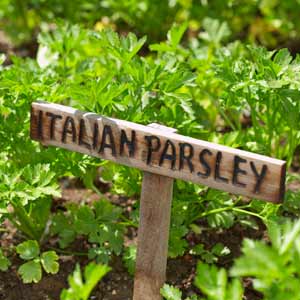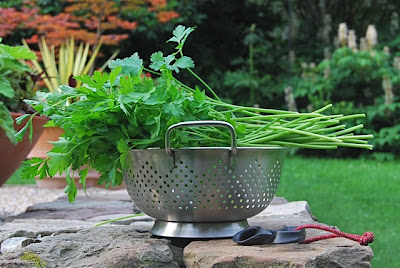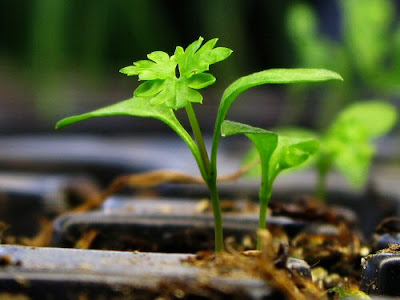
You know summer has truly arrived when you start seeing posh people ordering parsley soup at restaurants. Why posh people? Because parsley soup is expensive! Ok, it is a bit of a tenuous link but the point it that you need so much parsley to make the soup that it just isn't realistic or cost effective to buy half a dozen parsley plants from your local supermarkets fresh herb section - and you still may not have enough parsley!
 Of course the way to fix this is to grow your own parsley. Just one plant planted in the spring should produce enough foliage to make three batches of soup over the year, and each batch serves four hungry adults.
Of course the way to fix this is to grow your own parsley. Just one plant planted in the spring should produce enough foliage to make three batches of soup over the year, and each batch serves four hungry adults.But this is the truth of the matter. Although parsley is one of the most popular culinary herbs in use today, is also one of the trickiest herbs to grow. It doesn't like being transplanted, and it is stubborn to germinate from seed. This is rather unfortunate as growing parsley from seed is the only way in which it can be propagated.
In fact there are a couple of old English sayings:
‘… parsley only grows when a woman rules the house…’
'...parsley seed travels to hell and back seven times before it can germinate...' - bit spooky that one.
Growing Parsley
If you have purchased a pot of parsley, it just needs to be planted in a well-drained loamy soil. It will be happy in either full sun or light shade. DO NOT TEASE THE ROOTS, or you may as well just through you new plant in the bin, and then water in well. Don't worry too much when it starts to look poorly, which it will for a week or so, as it will eventually pick up. At that point water when necessary and start harvesting as a garnish once new growth is in abundance.
You can pick for parsley soup once your plant has about three times the amount you need, and then only harvest from the outside in.
How to grow parsley from seed
If you decide to sow directly outside you need a suitably prepared seed bed.
This can be started in the autumn (for a spring sowing) by adding plenty of well rotted manure and digging it deeply into the soil. This is important not only because parsley needs to be able to develop long tap roots, but it also has high nutritional requirements.
If you wish to crop parsley all year round you will need to prepare two different sites. The first (for harvesting during the summer) will need to be sited on a partially shaded - west or east facing – bed.
Whereas for winter harvesting you will need to be growing parsley on a sheltered, south facing bed. For both sites the soil will need to be free-draining, yet also able to retain its moisture – a difficult combination to achieve but difficult soils can be improved by adding plenty of organic matter such as leaf mould or composted bark.
Whereas for winter harvesting you will need to be growing parsley on a sheltered, south facing bed. For both sites the soil will need to be free-draining, yet also able to retain its moisture – a difficult combination to achieve but difficult soils can be improved by adding plenty of organic matter such as leaf mould or composted bark.
Germination is always very slow and during this period - anywhere between 3 and 8 weeks - the soil must be kept moist at all times otherwise the seed will not germinate. However try this tip for successful germination, soak the seeds overnight in warm water before sowing into shallow drills or alternatively, pour freshly boiled water along the seed drills just before planting. Whichever way you decide to use, once the seed is in place cover it very lightly with soil.
 Depending on how early you start your crop you may wish to give it some protection such as a cloche to help maintain soil temperatures.
Depending on how early you start your crop you may wish to give it some protection such as a cloche to help maintain soil temperatures.
Once the seedlings begin to emerge, water regularly and give it a good quality liquid feed - such as a seaweed extract - once a week.
Without sufficient water parsley can flower within its first season reducing its foliage growth and effecting its flavour. Cutting out the emerging flowering stalks will help with this, but it is not ideal solution.
Without sufficient water parsley can flower within its first season reducing its foliage growth and effecting its flavour. Cutting out the emerging flowering stalks will help with this, but it is not ideal solution.
As mentioned earlier, when harvesting the leaves, take them from the outside of the plants as new growth occurs at the centre.
Parsley is not a good herb for drying as it will quickly lose its flavour so either use it fresh, or keep in a plastic bag for storing in the freezer.
Parsley is not a good herb for drying as it will quickly lose its flavour so either use it fresh, or keep in a plastic bag for storing in the freezer.
For more information on herbs click onto:
How to Grow Garlic in Pots and Containers
How to grow Herbs from Seed
How to Grow Oregano from Seed
How to Grow Parsley
How to Grow Parsley from Seed Indoors
How to Grow Saffron
How to grow Herbs from Seed
How to Grow Oregano from Seed
How to Grow Parsley
How to Grow Parsley from Seed Indoors
How to Grow Saffron
How to Propagate the Saffron Crocus
What is Coriander?
What is Oregano?
What is Saffron?
Zafran
Images care of http://trade.indiamart.com/details.mp?offer=2118474448 and http://tinyfarmblog.com/parsley/ and http://awaytogarden.com/growing-and-storing-a-year-of-parsley
What is Coriander?
What is Oregano?
What is Saffron?
Zafran
Images care of http://trade.indiamart.com/details.mp?offer=2118474448 and http://tinyfarmblog.com/parsley/ and http://awaytogarden.com/growing-and-storing-a-year-of-parsley
